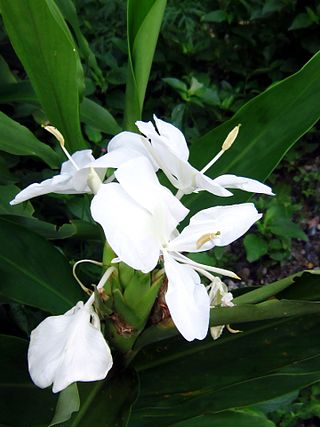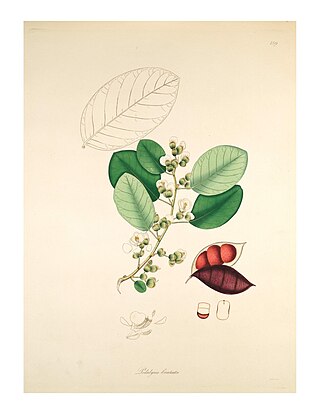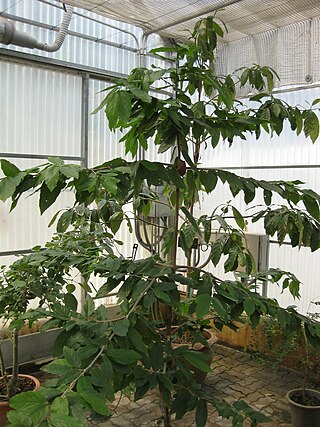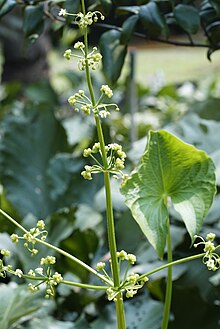
Aloe is a genus containing over 650 species of flowering succulent plants. The most widely known species is Aloe vera, or "true aloe". It is called this because it is cultivated as the standard source for assorted pharmaceutical purposes. Other species, such as Aloe ferox, are also cultivated or harvested from the wild for similar applications.

The pygmy hippopotamus or pygmy hippo is a small hippopotamid which is native to the forests and swamps of West Africa, primarily in Liberia, with small populations in Sierra Leone, Guinea, and Ivory Coast. It has been extirpated from Nigeria.

Amorphophallus is a large genus of some 200 tropical and subtropical tuberous herbaceous plants from the Arum family (Araceae), native to Asia, Africa, Australia and various oceanic islands. A few species are edible as "famine foods" after careful preparation to remove irritating chemicals. The genus includes the Titan arum of Indonesia, which has the largest inflorescence of any plant in the genus, and is also known as the 'corpse flower' for the pungent odour it produces during its flowering period, which can take up through seven years of growth before it occurs.

Cymbopogon, also known as lemongrass, barbed wire grass, silky heads, Cochin grass, Malabar grass, oily heads, citronella grass or fever grass, is a genus of Asian, African, Australian, and tropical island plants in the grass family. Some species are commonly cultivated as culinary and medicinal herbs because of their scent, resembling that of lemons . The name cymbopogon derives from the Greek words kymbe and pogon "which mean [that] in most species, the hairy spikelets project from boat-shaped spathes." Lemongrass and its oil are believed to possess therapeutic properties.

Tamarind is a leguminous tree bearing edible fruit that is indigenous to tropical Africa and naturalized in Asia. The genus Tamarindus is monotypic, meaning that it contains only this species. It belongs to the family Fabaceae.
Neoboutonia is a plant genus of the family Euphorbiaceae first described as a genus in 1864. It is the only genus in subtribe Neoboutoniinae, and native to tropical Africa. It is dioecious.
- Neoboutonia macrocalyx Pax - Burundi, Cameroon, Rwanda, Zaire, Kenya, Tanzania, Uganda, Malawi, Zambia, Zimbabwe
- Neoboutonia manniiBenth. & Hook.f. - tropical Africa from Liberia to Mozambique
- Neoboutonia melleri(Müll.Arg.) Prain - tropical Africa from Nigeria to Mozambique

Hedychium coronarium, the white garland-lily or white ginger lily, is a perennial flowering plant in the ginger family Zingiberaceae, native to the forest understorey of Asia.

Ancistrocladus is a genus of woody lianas in the monotypic family Ancistrocladaceae. The branches climb by twining other stems or by scrambling with hooked tips. They are found in the tropics of the Old World.

Daphniphyllum is the sole genus in the flowering plant family Daphniphyllaceae and was described as a genus in 1826. The genus includes evergreen shrubs and trees mainly native to east and southeast Asia, but also found in the Indian Subcontinent and New Guinea.
Thomandersia is the sole genus in the Thomandersiaceae, an African family of flowering plants. Thomandersia is a genus of shrubs and small trees, with six species native to Central and West Africa.

Monodora myristica, the calabash nutmeg, is a tropical tree of the family Annonaceae or custard apple family of flowering plants. It is native to Angola, Benin, Cameroon, the Central African Republic, the Democratic Republic of the Congo, Equatorial Guinea, Gabon, Ghana, Guinea-Bissau, Ivory Coast, Kenya, Liberia, Nigeria, the Republic of the Congo, Sierra Leone, Sudan, Tanzania, Togo and Uganda. In former times, its seeds were widely sold as an inexpensive nutmeg substitute. This is now less common outside its region of production. Other names of calabash nutmeg include Jamaican nutmeg, African nutmeg, ehuru, ariwo, awerewa, ehiri, airama, African orchid nutmeg, muscadier de Calabash and lubushi.
Sapo National Park is a national park in Sinoe County, Liberia. It is the country's largest protected area of rainforest, was the first national park established in the country, and contains the second-largest area of primary tropical rainforest in West Africa after Taï National Park in neighbouring Côte d'Ivoire. Agriculture, construction, fishing, hunting, human settlement, and logging are prohibited in the park.

Lasimorpha is a monotypic genus of flowering plants in the family Araceae. The single species that makes up the genus is Lasimorpha senegalensis. This species is native to western and central Africa, from Liberia east to Chad and south to Angola.

Dalhousiea is a genus of flowering plants in the legume family, Fabaceae. It belongs to the subfamily Faboideae. It includes two species, one native to central Africa, and the other to eastern India, Bangladesh, and Myanmar.
Belonophora coffeoides is a species of flowering plant in the family Rubiaceae. It is found in Tropical Africa. It is the type species of the genus Belonophora.

The West African mud turtle, also known as the West African side-necked turtle or swamp terrapin, is a species of turtle in the family Pelomedusidae. Pelusios castaneus is a freshwater species and is endemic to West and Central Africa.

Hypselodelphys is a group of plants in the Marantaceae described as a genus in 1950. native to tropical Africa from Liberia to Uganda and south to Angola. It contains 8 recognized species:

Urobotrya is a genus of plants in the family Opiliaceae described as a genus in 1905.
Abrus melanospermus is a species of flowering plant in the pea and bean family Fabaceae. It is native to Africa and Asia. It was also introduced to South America.

Mansonia is a genus of flowering plants. It includes five species of large evergreen or deciduous trees. The species are native to tropical Africa and southeastern Asia.















